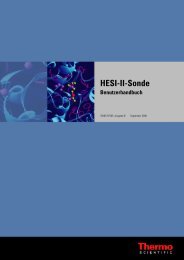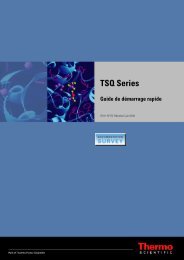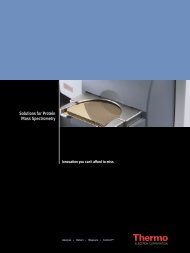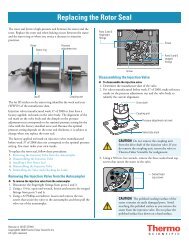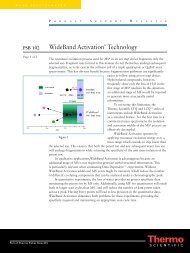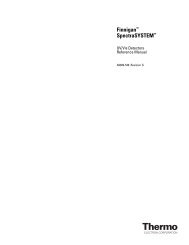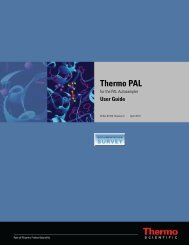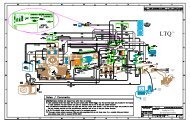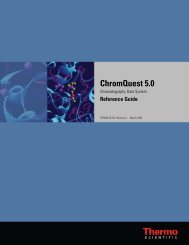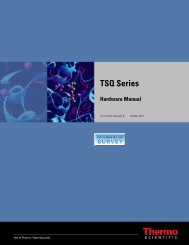LTQ Orbitrap XL Hardware Manual
LTQ Orbitrap XL Hardware Manual
LTQ Orbitrap XL Hardware Manual
Create successful ePaper yourself
Turn your PDF publications into a flip-book with our unique Google optimized e-Paper software.
type and selected ion monitoring (SIM) scan<br />
type.<br />
MSDS Material Safety Data Sheet<br />
MS/MS Mass spectrometry/mass spectrometry, or<br />
tandem mass spectrometry is an analytical<br />
technique that involves two stages of mass<br />
analysis. In the first stage, ions formed in the ion<br />
source are analyzed by an initial analyzer. In the<br />
second stage, the mass-selected ions are<br />
fragmented and the resultant ionic fragments are<br />
mass analyzed.<br />
MSn scan mode The scan power equal to 1 to 10,<br />
where the scan power is the power n in the<br />
expression MSn. MSn is the most general<br />
expression for the scan mode, which can include<br />
the following:<br />
• The scan mode corresponding to the one stage<br />
of mass analysis in a single-stage full-scan<br />
experiment or a selected ion monitoring (SIM)<br />
experiment<br />
• The scan mode corresponding to the two stages<br />
of mass analysis in a two-stage full-scan<br />
experiment or a selected reaction monitoring<br />
(SRM) experiment<br />
• The scan mode corresponding to the three to<br />
ten stages of mass analysis (n = 3 to n = 10) in a<br />
multi-stage full-scan experiment or a<br />
consecutive reaction monitoring (CRM)<br />
experiment.<br />
See also MS scan modes and MS/MS.<br />
multipole A symmetrical, parallel array of<br />
(usually) four, six, or eight cylindrical rods that<br />
acts as an ion transmission device. An RF voltage<br />
and dc offset voltage are applied to the rods to<br />
create an electrostatic field that efficiently<br />
transmits ions along the axis of the multipole<br />
rods.<br />
m/z Mass-to-charge ratio. An abbreviation used to<br />
denote the quantity formed by dividing the mass<br />
of an ion (in u) by the number of charges carried<br />
Glossary: MSDS<br />
by the ion.<br />
For example, for the ion C 7 H 7 2+ , m/z = 45.5.<br />
n nano (10 -9 )<br />
nanospray ionization (NSI) A type of<br />
electrospray ionization (ESI) that accommodates<br />
very low flow rates of sample and solvent on the<br />
order of 1 to 20 nL/min (for static nanospray) or<br />
100 to 1000 nL/min (for dynamic nanospray).<br />
NCBI National Center for Biotechnology<br />
Information (USA)<br />
NIST National Institute of Standards and<br />
Technology (USA)<br />
NMR Normal Mass Range<br />
NSI See nanospray ionization (NSI).<br />
octapole An octagonal array of cylindrical rods<br />
that acts as an ion transmission device. An RF<br />
voltage and dc offset voltage applied to the rods<br />
create an electrostatic field that transmits the ions<br />
along the axis of the octapole rods.<br />
OD outside diameter<br />
OT <strong>Orbitrap</strong><br />
Ω ohm<br />
p pico (10 -12 )<br />
Pa pascal<br />
PCB printed circuit board<br />
PDA detector Photodiode Array detector is a<br />
linear array of discrete photodiodes on an<br />
integrated circuit chip. It is placed at the image<br />
plane of a spectrometer to allow a range of<br />
wavelengths to be detected simultaneously.<br />
PE protective earth<br />
PID proportional / integral / differential<br />
Thermo Fisher Scientific <strong>LTQ</strong> <strong>Orbitrap</strong> <strong>XL</strong> <strong>Hardware</strong> <strong>Manual</strong> G-5



